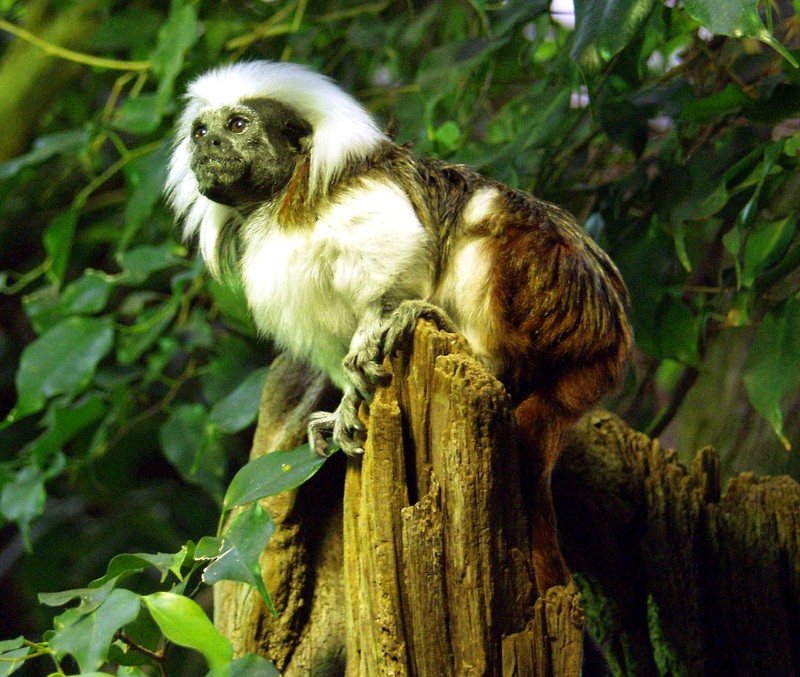|
| 질의: Small white | 결과: 1016번째/2237 | |
Cottontop Tamarin (Saguinus oedipus) - Wiki
| 제목: | Cottontop Tamarin (Saguinus oedipus) - Wiki
| |

| 해상도: 1500x1270
파일크기: 512186 Bytes
촬영일: 2005:03:27 16:18:30
사진기: E-20,E-20N,E-20P (OLYMPUS OPTICAL CO.,LTD)
F number: f/2.0
Exposure: 1/80 sec
Focal Length: 260/10
등록시간: 2007:10:08 23:56:45
|
Cottontop Tamarin
From Wikipedia, the free encyclopedia
[Photo] Cottontop Tamarin (Saguinus oedipus) in Zoo Duisburg. Date 27. M??r. 2005. Author Raimond Spekking (http://commons.wikimedia.org/wiki/User:Raymond) Copyright (C) 2005 Raimond Spekking
Permission is granted to copy, distribute and/or modify this document under the terms of the GNU Free Documentation License, Version 1.2 or any later version published by the Free Software Foundation; with no Invariant Sections, no Front-Cover Texts, and no Back-Cover Texts. A copy of the license is included in the section entitled "GNU Free Documentation License". |
The Cottontop Tamarin (Saguinus oedipus), also known as the Pinch?? Tamarin, is a small New World monkey weighing less than 1lb (0.5 kg). It is found in tropical forest edges and secondary forests where it is arboreal and diurnal.
Description
This tamarin species has a long crest, white hairs from forehead to nape flowing over the shoulders. The back is brown, and the underparts, arms and legs are whitish-yellow. Rump and inner thighs are reddish-orange. They are most active from sunrise to sunset, they spend a large portion of their activity time foraging for animal prey, searching through leaves and along branches, and peering and reaching into holes and crevices in branches and tree trunks. When alarmed or excited, Cottontop Tamarins raise the hair on the crown of their head and stand up tall to make themselves look bigger.
The Cottontop Tamarin eats fruit, insects, new leaves or buds, small lizards and nectar. It is called "Liszt Monkey" in German due to its supposed resemblance to the composer Franz Liszt.
Groups of Cottontop Tamarins usually include 3 - 9 individuals. Group members are not necessarily all related. In addition to a dominant mated pair and their young, there may be transient individuals, probably young animals of both sexes. The home ranges of adjacent groups overlap. Like most tamarins, the Cottontop Tamarin usually gives birth to twins, although single births and triplets happen occasionally. Tamarins reproduce year round with a gestation of 183 days. Both parents care for the young. Males and juveniles usually carry the young, giving them to the females for nursing. Weaning begins at four to five weeks and youngsters reach sexual maturity at 12 to 15 months.
Up to the 1980s, the Cottontop Tamarin was thought to occur from Costa Rica south to northern Colombia. By 1992 it could be found only in northern Colombia. Significant exports for biomedical research contributed to the Cottontop Tamarin's decline in the late 1960s and early 1970s. Currently, deforestation is the greatest threat.
http://en.wikipedia.org/wiki/Cottontop_Tamarin
| The text in this page is based on the copyrighted Wikipedia article shown in above URL. It is used under the GNU Free Documentation License. You may redistribute it, verbatim or modified, providing that you comply with the terms of the GFDL. |
|
^o^
동물그림창고 똑똑전화 누리집
^o^
|
|

